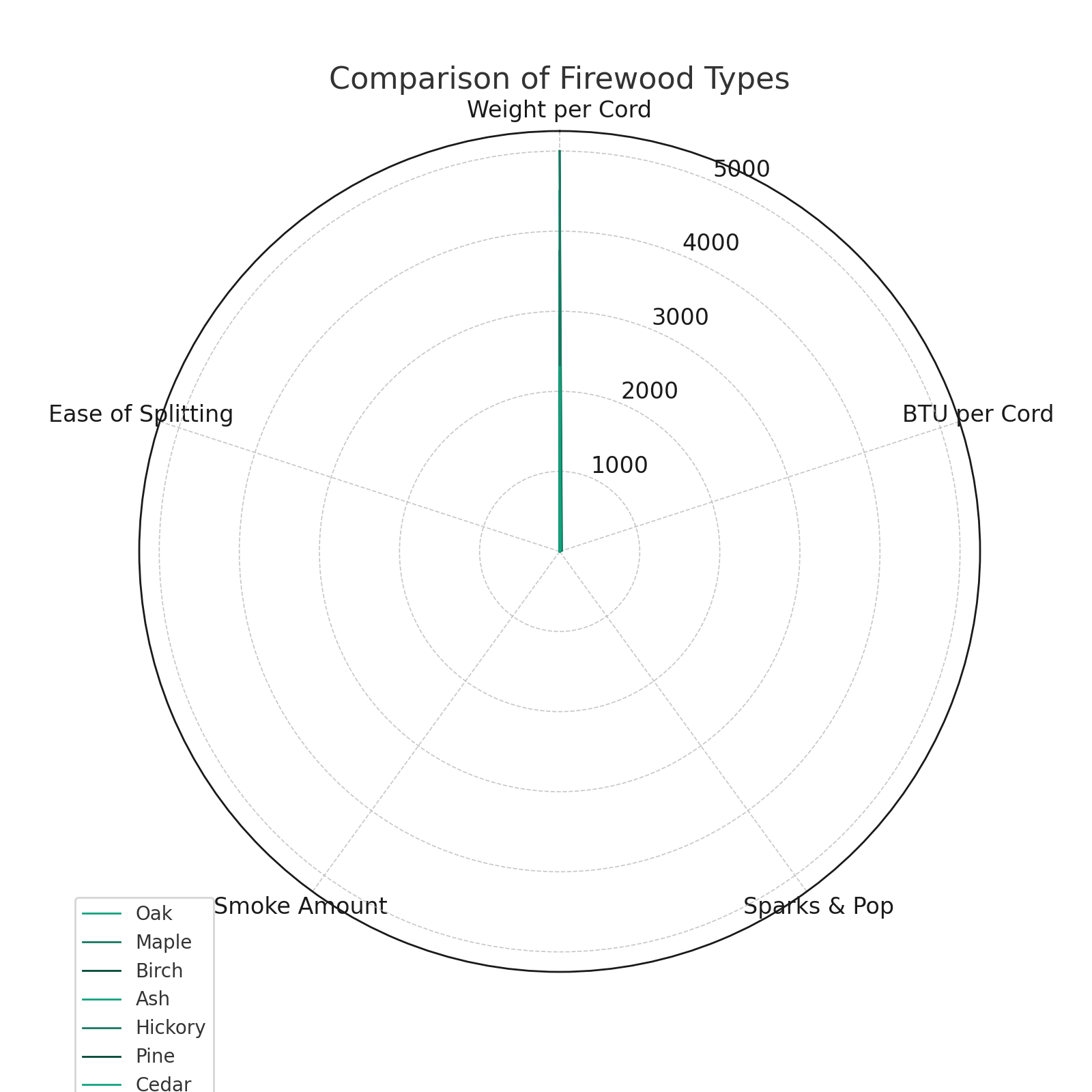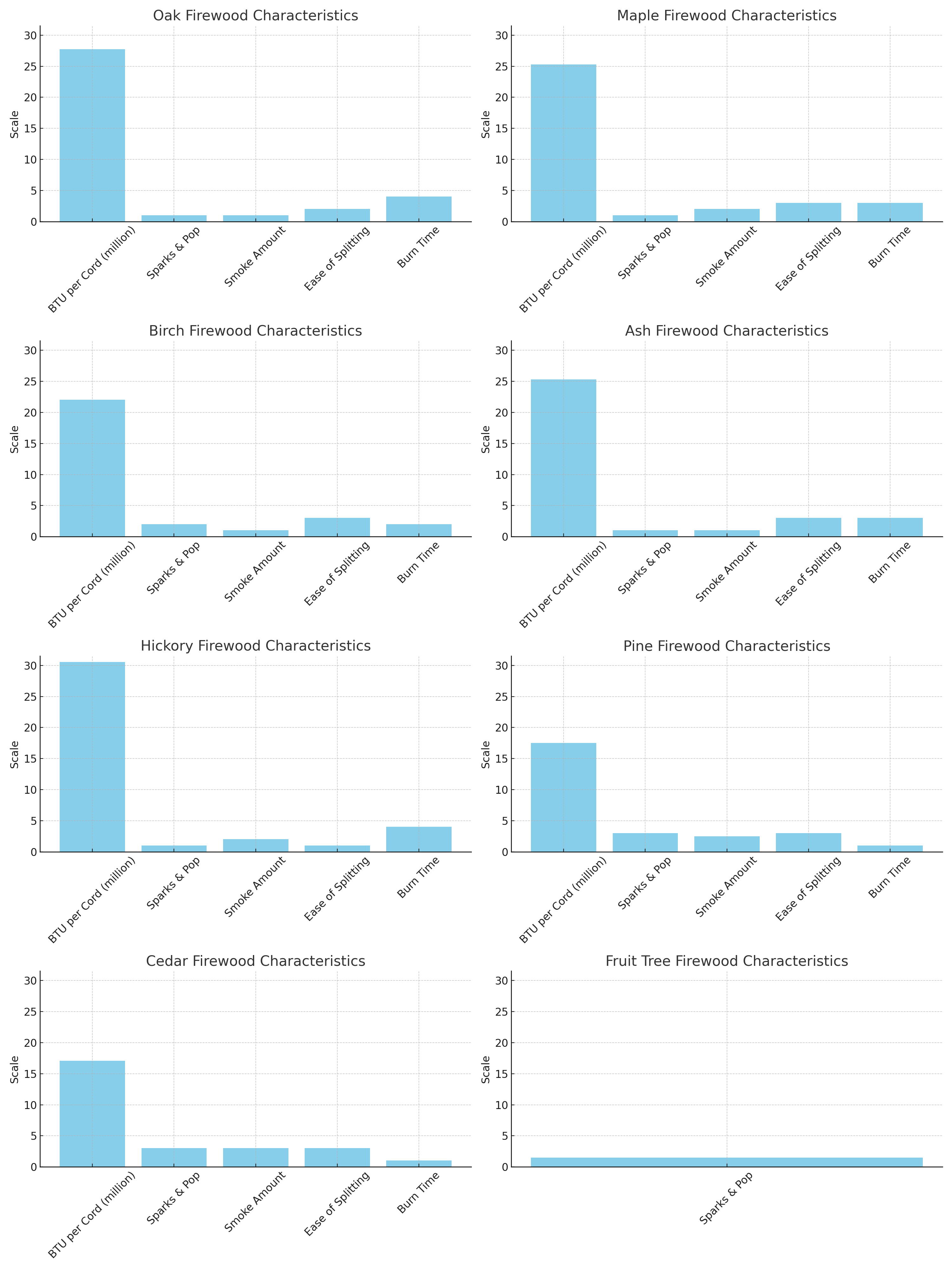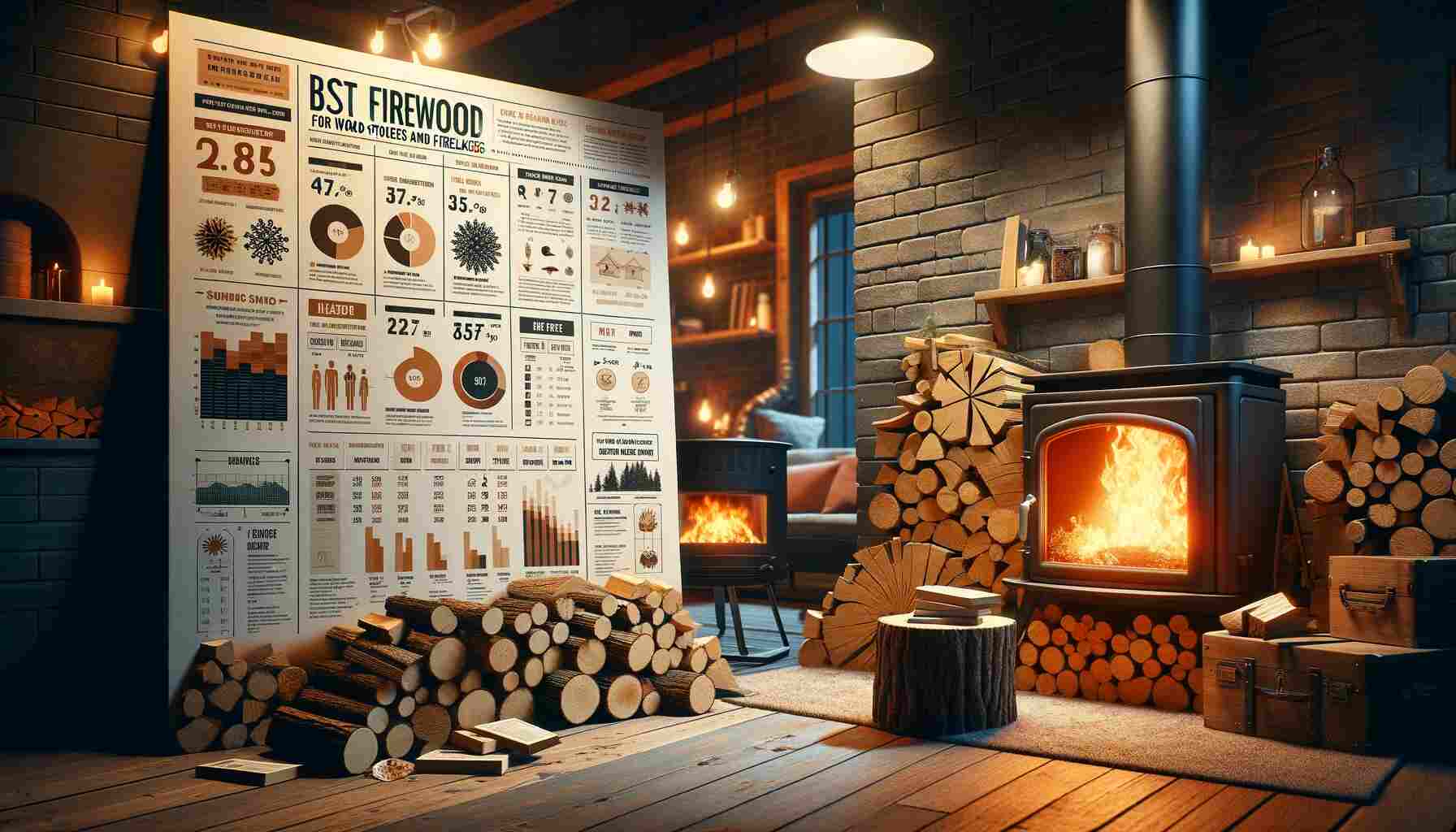We all know that not all firewood is created equal. Choosing the right type of firewood can make a significant difference in terms of heat output, burn time, and even the amount of smoke produced. With so many options out there, it can be overwhelming to figure out which is the best firewood to burn for your wood stoves and fireplaces that fits your needs. That’s where this comprehensive firewood guide comes in handy.
The best firewood options for wood stoves and fireplaces are oak, maple, birch, ash, and hickory. Oak offers a long and sustained burn with low smoke. Maple provides high heat output and even burns. Birch burns efficiently and releases a pleasant aroma. Ash produces clean-burning fires with minimal smoke. Hickory is excellent for cooking and offers prolonged heat.
These firewood types are popular due to their qualities, making them top choices for wood stoves and fireplaces.
Let’s discuss their heat output (measured in million BTUs), burn time, smoke production, and ease of splitting. I’ll also be sharing a detailed firewood chart to help you make the best choice for your specific needs.
Let’s dive right in!
Understanding Firewood Basics
Before I jump into the nitty-gritty details of different firewood options, let’s start by understanding the basics of firewood. By grasping these fundamental concepts, you’ll be better equipped to make informed decisions when it comes to selecting the best firewood for your needs.
First and foremost, it’s essential to recognize the importance of choosing the right firewood. The type of wood you burn can significantly impact the quality and efficiency of your fire. It affects factors such as heat output, burn time, smoke production, and even the buildup of creosote in your chimney.
Key Factors to Consider
When selecting firewood, there are a few key factors to consider.
1. Moisture Content
Moisture content plays a crucial role in firewood performance. Freshly cut or “green” wood contains a high moisture content, making it difficult to burn efficiently. It produces less heat and creates excessive smoke. On the other hand, properly seasoned firewood, with a moisture content of around 20% or less, burns cleaner and generates more heat.
2. BTU (British Thermal Unit)
BTU is a unit of measurement used to quantify the heat energy produced by a specific type of firewood. The higher the BTU value, the more heat the firewood will generate. BTU values can vary widely between different types of wood, so it’s worth considering this when making your selection.
3. Wood Density
The density of firewood affects both its burn time and heat output. Dense hardwoods, such as oak and hickory, have a higher density and generally burn longer, providing a sustained source of heat. Softer woods, like pine, burn more quickly but can be excellent for starting fires due to their lower density.
4. Smoke and Creosote Production
Some types of firewood produce more smoke and creosote than others. Creosote is a flammable substance that can accumulate in your chimney and pose a fire hazard if not properly maintained. Choosing firewood with low smoke and creosote production can help keep your chimney cleaner and reduce the risk of chimney fires.

Best Firewood to Burn for Wood Stoves and Fireplaces
Now, let’s dive into the exciting part—exploring the best firewood options for wood stoves and fireplaces. We’ll take a closer look at various types of firewood, their characteristics, BTU values, burn times, and other important factors to help you make an informed choice.
| Firewood Type | Weight (lbs per cord – Seasoned) | Heat per cord (million BTUs) | Sparks & Pop | Amount of Smoke | Ease of Splitting |
| Oak | 4,000 – 5,000 | 26.4 – 29.1 | Low | Low | Moderate |
| Maple | 3,500 – 4,000 | 24.2 – 26.4 | Low | Moderate | Easy |
| Birch | 2,700 – 3,200 | 20.5 – 23.6 | Moderate | Low | Easy |
| Ash | 3,000 – 4,000 | 24.2 – 26.4 | Low | Low | Easy |
| Hickory | 4,500 – 5,500 | 29.1 – 32.0 | Low | Moderate | Difficult |
The table above presents a comparison of different firewood types for wood stoves and fireplaces. It includes information on the weight (in pounds per cord when seasoned), heat output (in million BTUs per cord), sparks and popping, amount of smoke produced, and ease of splitting.
Oak Firewood
Oak is a popular choice for firewood due to its dense nature and high BTU value. It provides a steady and long-lasting heat source. Oak firewood burns slowly and can provide sustained heat for extended periods, making it ideal for chilly winter nights.
While oak can be a bit challenging to split due to its density, its durability makes it easier to handle and stack. Oak produces relatively low amounts of smoke and creosote, contributing to cleaner and safer wood-burning.
Maple Firewood
Maple firewood offers a high heat value and respectable BTU rating, making it an excellent choice for heating your space. It burns evenly and leaves behind long-lasting coals, which can help maintain a consistent fire and extend burn times. Whether you have a wood stove or a traditional fireplace, maple firewood performs well in both settings.
Birch Firewood
Birch firewood provides a decent BTU output and is known for its efficient burning properties. It’s important to ensure birch firewood is properly seasoned to avoid excessive moisture content. Removing the bark can expedite drying. Birch logs add a touch of beauty to your fireplace with their distinct white bark, and they release a pleasant fragrance when burned.
Ash Firewood
Ash firewood offers a high BTU content, providing ample heat to warm your home effectively. Burning ash firewood results in minimal smoke production and creosote buildup, reducing maintenance needs for your chimney. Ash firewood is versatile and performs well in both wood stoves and fireplaces.
Hickory Firewood:
Hickory is renowned for its exceptional heat output, making it an excellent choice for those seeking maximum warmth. Hickory’s distinct flavor makes it a popular choice for cooking and smoking meats, infusing food with a delicious taste. Hickory is one of the hardest and densest firewoods, which can make splitting more challenging. However, its durability ensures a longer-lasting fire.

Additional Firewood Options
In addition to the previously discussed firewood types, let’s explore some additional options that can add variety and versatility to your wood-burning experience.
Pine Firewood
- Weight (lbs per cord – Seasoned): 2,000 – 2,500
- Heat per cord (million BTUs): 15.6 – 19.4
- Sparks & Pop: High
- Amount of Smoke: Moderate to High
- Ease of Splitting: Easy
Pine firewood is known for its quick ignition and abundance, making it a popular choice for starting fires. It has a lower density compared to hardwoods, which means it burns faster and provides a warm, crackling fire. However, keep in mind that pine produces more smoke and sparks, and it’s recommended for use in well-ventilated areas or outdoor fire pits.
Cedar Firewood
- Weight (lbs per cord – Seasoned): 2,100 – 2,500
- Heat per cord (million BTUs): 14.8 – 19.4
- Sparks & Pop: High
- Amount of Smoke: High
- Ease of Splitting: Easy
Cedar firewood is valued for its pleasant aroma and natural insect-repellent properties. It burns relatively quickly and provides a cozy atmosphere. However, it’s important to note that cedar firewood produces a significant amount of smoke and sparks, so it’s advisable to use it primarily in outdoor settings, such as campfires or fire pits.
Fruit Tree Firewood (e.g., Apple, Cherry, Pear)
- Weight (lbs per cord – Seasoned): Varies
- Heat per cord (million BTUs): Varies
- Sparks & Pop: Low to Moderate
- Amount of Smoke: Low to Moderate
- Ease of Splitting: Varies
Fruit tree firewood, such as apple, cherry, or pear, offers a unique burning experience. While it may not have the highest BTU output compared to hardwoods, it is known for its pleasant aroma and can infuse a subtle fruity fragrance into the air. Fruit tree firewood is often prized for cooking and adds a special touch to the flavor of grilled or smoked foods. Keep in mind that the weight, heat output, and ease of splitting can vary depending on the specific fruit tree.
Remember, when using any firewood, it’s essential to ensure proper seasoning to reduce moisture content and improve burn efficiency. Additionally, practicing good fire safety measures, such as using a screen or spark guard, is important to prevent sparks from escaping the fireplace or wood stove.
With these additional firewood options, you have a wider range of choices to suit different needs, preferences, and purposes. Select the firewood that aligns best with your specific requirements, whether it’s for quick kindling, ambient fires, or even enhancing the flavors of your culinary endeavors.
Factors Influencing Firewood Quality
When it comes to firewood, several factors can influence its quality and performance. Understanding these factors will help you select the best firewood for your wood stove or fireplace. Let’s take a closer look at the key factors that influence firewood quality:
1. Moisture Content and Seasoning
Firewood with high moisture content, often referred to as “green” wood, is challenging to burn and produces less heat. It’s crucial to choose well-seasoned firewood with a moisture content of around 20% or less. Properly seasoned firewood burns more efficiently, provides better heat output, and reduces the production of smoke and creosote.
2. Wood Density and Weight
The density of firewood affects its burn time and heat output. Dense hardwoods, such as oak and hickory, have a higher density and burn longer, providing sustained heat. Softer woods, like pine, have lower density and burn more quickly, making them suitable for kindling and starting fires.
3. Log Size and Splitting Techniques
The size of firewood logs can impact how they burn. Smaller logs tend to ignite and burn more quickly, while larger logs provide a longer burn time. It’s important to consider the size that works best for your wood stove or fireplace. Additionally, using proper splitting techniques, such as using a sharp axe or a log splitter, can make the splitting process easier and more efficient.
4. Proper Storage and Drying Methods
Firewood should be stored properly to maintain its quality. It should be stored in a well-ventilated area, protected from rain and snow, and elevated off the ground to prevent moisture absorption. Adequate airflow allows for further drying, ensuring the firewood remains properly seasoned.
Conclusion
In conclusion, the right firewood can greatly enhance your wood-burning experience. Hardwoods like oak, maple, birch, ash, and hickory offer high heat output and longer burn times, making them ideal for efficient indoor heating. Softwoods such as pine are excellent for kindling, while cedar and fruit tree varieties add unique aromas and flavors, particularly in outdoor settings.
Remember, the best firewood choice depends on your specific needs, whether for warmth, ambiance, or cooking. Above all, prioritize safety and sustainability in your wood-burning practices to ensure a pleasant and responsible experience.
Here’s a detailed table that provides comprehensive information about different firewood types and their characteristics:
| Firewood Type | Characteristics | BTU Value Range | Burn Time | Smoke Production | Ease of Splitting |
|---|---|---|---|---|---|
| Oak | Dense and long-burning | 24.2 – 29.1 million | Extended burn time | Low | Moderate |
| Maple | High heat output and even burn | 20.5 – 26.4 million | Sustained heat | Moderate | Easy |
| Birch | Efficient burning and pleasing aroma | 18.7 – 23.6 million | Moderate burn time | Low | Easy |
| Ash | High heat output and minimal smoke | 20.5 – 26.4 million | Long-lasting fire | Low | Easy |
| Hickory | Excellent heat and ideal for cooking | 26.4 – 32.0 million | Extended burn time | Moderate | Difficult |
| Pine | Quick ignition and good for kindling | 15.6 – 19.4 million | Shorter burn time | Moderate to high | Easy |
| Cedar | Pleasant aroma, better for outdoor use | 14.8 – 19.4 million | Short burn time | High | Easy |
| Fruit Tree | Adds unique flavor to cooking | Varies | Varies | Low to moderate | Varies |





